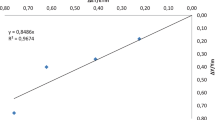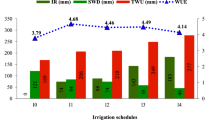Abstract
The agricultural use of water is higher than 85% in the western USA, resulting in an increasing water deficit in the region; this situation is commonly encountered throughout the world where irrigated and irrigation-assisted production systems are operational. The objective of this study was to examine differences among dry bean (Phaseolus vulgaris L.) landraces and cultivars in terms of water use efficiency (WUE), subsequently identifying those with a high water use efficiency. Six medium-seeded (25–40 g 100 seed wt−1) landraces and cultivars of pinto and red market classes were evaluated in intermittent drought-stressed (DS) and non-stressed (NS) environments at Kimberly, Idaho, USA in 2003 and 2004. Each market class comprised one each of a landrace and old and new cultivars. Mean evapotranspiration (ET) in the NS environment was 384 mm in 2003 and 432 mm in 2004; the respective ET values in the DS environment were 309 and 268 mm. Mean seed yield was higher in the DS (2678 kg ha−1) and NS (3779 kg ha−1) environments in 2004 than in 2003 (688 and 1800 kg ha−1, respectively). Under severe drought stress in 2003, WUE in the pinto bean ranged from 1.5 for the Common Pinto landrace to 4.4 kg ha−1 mm−1 water for cv. Othello. The Common Red Mexican landrace had the highest WUE (3.7), followed by cvs. NW 63 (2.8) and UI 259 (1.4) in the red market class. Under favorable milder climatic conditions in 2004, the mean WUE value was 10 kg ha−1 mm−1 water in the DS environment and 8.7 kg ha−1 mm−1 water in the NS environment. We conclude that dry bean landraces and cultivars with high WUE should be used to reduce dependence on irrigation water and to develop drought-resistant cultivars to maximize yield and WUE.

Similar content being viewed by others
Abbreviations
- DS:
-
Intermittent drought-stressed
- DSI:
-
Drought susceptibility index
- ET:
-
Evapotranspiration
- NS:
-
Non-stressed
- PR:
-
Percentage reduction in seed yield due to drought stress
- WUE:
-
Water use efficiency
References
Abebe AS, Brick MA (2003) Traits associated with dry edible bean (Phaseolus vulgaris L.) productivity under diverse soil moisture environments. Euphytica 133:339–347
Al-Kaisi MM, Berrada AF, Stack MW (1999) Dry bean response to different irrigation rates in southwestern Colorado. J Prod Agric 12:422–427
Allen RG, Pereira LS, Raes D, Smith M (1998) Crop evapotranspiration – Guidelines for computing water requirements. FAO irrigation and drainage paper No 56. Food and Agriculture Organization of the United Nations, Rome, Italy
Allen RG, Yonts CD, Wright JL (2000) Irrigation to maximize bean production and water use efficiency. In: Singh SP (Ed), Bean Research, Production, and Utilization. Proc Idaho Bean Workshop. University of Idaho, Moscow, pp 71–92
Anderson RL, Tanaka DL, Merrill SD (2003) Yield and water use of broadleaf crops in a semiarid climate. Agric Water Manag 58:255–266
Burke DW (1982) Registration of red Mexican beans Rufus, NW-59, and NW-63. Crop Sci 22:685–686
Burke DW, Silbernagel MJ, Kraft JM, Koehler HH (1995) Registration of ‘Othello’ pinto bean. Crop Sci 35:943
Calvache M, Reichardi K, Bacchi O, Dourado-Neto D (1997) Deficit irrigation at different growth stages of the common bean (Phaseolus vulgaris L., cv. Imbabello). Sci Agric 54(Special):1–16
Doorenbos J, Kassam AH (1979) Yield response to water. FAO Irrigation and Drainage Paper No. 33. Food and Agriculture Organization of the United Nations, Rome, Italy
Fischer RA, Maurer R (1978) Drought resistance in spring wheat cultivars. I. Grain yield responses. Aust J Agric Res 29:897–912
Frahm MA, Rosas JC, Mayek-Perez N, Lopez-Salinas E, Acosta-Gallegos JA, Kelly JD (2004) Breeding beans for resistance to terminal drought in the lowland tropics. Euphytica 136:223–232
Guida dos Santos M, Vasconcelos R, Ferraz R, Pimentel C (2004) Gas exchange and yield response to foliar phosphorus application in Phaseolus vulgaris L. under drought. Bras J Plant Physiol 16:171–179
Jones H (2004) What is water use efficiency? In: Bacon MA (eds) Water use efficiency in plant biology. Blackwell, Oxford, pp 27–41
Libardi PL, Moraes SO, Saad AM, Lier Q, Vieira O, Tuon RL (1999) Nuclear techniques to evaluate water use of field crops irrigated in different growth stages. In: Kirda C, Moutonnet P, Hera C, Nielsen DR (eds) Crop yield response to deficit irrigation. Kluwer, Dordrecht, pp 109–120
Mahlooji M, Mousavi SF, Karimi M (2000) The effects of water stress and planting date on yield and yield components of pinto bean (Phaseolus vulgaris). J Sci Technol Agric Nature Res 4:57–68
Masaya P, White JW (1991) Adaptation to photoperiod and temperature. In: van Schoonhoven A, Voysest O (eds) Common beans: research for crop improvement. CAB Int/CIAT, Wallingford/Cali, pp 445–500
Merrill SD, Tanaka DL, Hanson JD (2002) Root length growth of eight crop species in haplustoll soils. Soil Sci Soc Am J 66:913–923
Miller PR, McConkey BG, Clayton GW, Brandt SA, Staricka JA, Johnston AM, Lafond GP, Schatz BG, Baltensperger DD, Neill KE (2002) Pulse crop adaptation in the northern Great Plains. Agron J 94:261–272
Mimms OL, Zaumeyer WJ (1947) Growing dry bean in the Western States. Farmers’ Bulletin No. 1996. U.S. Dept. Agric., Washington D.C.
Muñoz-Perea CG (2005) Differences among dry bean landraces and cultivars for seed yield, water use efficiency, and nutrient concentration in drought-stressed and non-stressed environments. PhD dissertation, University of Idaho, Moscow, Idaho
Muñoz-Perea CG, Allen R, Wright J, Westermann D, Terán H, Dennis M, Singh SP (2005) Drought resistance, water use efficiency and nutrient uptake by old and new dry bean cultivars. Annu Rpt Bean Improv Coop 48:144–145
Muñoz-Perea CG, Terán H, Allen RG, Wright JL, Westermann DT, Singh SP (2006) Selection for drought resistance in dry bean landraces and cultivars. Crop Sci 46:2111–2120
Myers JR, Stewart-Williams KD, Hayes RE, Kolar JJ, Singh SP (2001a) Registration of ‘UI 259’ red dry bean. Crop Sci 41:1643–1644
Myers JR, Stewart-Williams KD, Hayes RE, Kolar JJ, Singh SP (2001b) Registration of ‘UI 320’ pinto dry bean. Crop Sci 41:1642–1643
North GB, Nobel PS (1997) Root-soil contact for the desert succulent Agave deserti in wet and drying soil. New Phytol 135:21–29
Padilla-Ramírez JS, Acosta-Gallegos JA, Acosta-Díaz E, Mayek-Pérez N, Kelly JD (2005) Partitioning and partitioning rate to seed yield in drought-stressed and non-stressed dry bean genotypes. Annu Rpt Bean Improv Coop 48:152–153
Pimentel C, Laffray D, Louguet P (1999) Intrinsic water use efficiency at the pollination stage as a parameter for drought tolerance in Phaseolus vulgaris. Physiol Plant 106:184–189
Ramírez-Vallejo P, Kelly J (1998) Traits related to drought resistance in common bean. Euphytica 99:127–136
Ramos MLG, Gordon AJ, Minchin FR, Sprent JI, Parsons R (1999) Effect of water stress on nodule physiology and biochemistry of a drought tolerant cultivar of common bean (Phaseolus vulgaris L.). Ann Bot 83:57–63
SAS Institute (2004) Base SAS 9.1.3: Procedures guide. SAS Institute, Cary, N.C.
Serraj R, Sinclair TR (1998) N2 fixation response to drought in common bean (Phaseolus vulgaris L.). Ann Bot 82:229–234
Singh SP (1989) Patterns of variation in cultivated common bean (Phaseolus vulgaris, Fabaceae). Econ Bot 43:39–57
Singh SP (1995) Selection for water-stress tolerance in interracial populations of common bean. Crop Sci 35:118–124
Singh SP, Gepts P, Debouck DG (1991) Races of common bean (Phaseolus vulgaris, Fabaceae). Econ Bot 45:379–396
Singh SP, Hayes R, Robison C, Dennis M, Powers E (2001) Response of bean (Phaseolus vulgaris L.) cultivars to drought stress. Annu Rpt Bean Improv Coop 44:45–46
Sponchiado BN, White JW, Castillo JA, Jones PG (1989) Root growth of four common bean cultivars in relation to drought tolerance in environments with contrasting soil types. Exp Agric 25:249–257
Terán H, Singh SP (2002) Comparison of sources and lines selected for drought resistance in common bean. Crop Sci 42:64–70
White JW, Castillo JA (1992) Evaluation of diverse shoot genotypes on selected root genotypes of common bean under soil water deficits. Crop Sci 32:762–765
White JW, Castillo JA, Ehleringer JR, García-C JA, Singh SP (1994a) Relations of carbon isotope discrimination and other physiological traits to yield in common bean (Phaseolus vulgaris) under rainfed conditions. J Agric Sci 122:275–284
White JW, Izquierdo J (1991) Physiology of yield potential and stress tolerance In: van Schoonhoven A, Voysest O (eds) Common beans: research for crop improvement. CAB Int/CIAT, Wallingford/Cali, pp 287–382
White JW, Ochoa R, Ibarra F, Singh SP (1994b) Inheritance of seed yield, maturity and seed weight of common bean (Phaseolus vulgaris) under semi-arid rainfed conditions. J Agric Sci 122:265–273
Wright JL (1982) New evapotranspiration crop coefficients. J Irrig Drain Div ASCE 108:57–74
Acknowledgments
Financial support received from the USDA-Western Regional Sustainable Agricultural Research and Education program (Project no. WS02-038) from 2002 to 2005 is highly appreciated. C.G. Muñoz was also partially funded through the Graduate Research Assistantship from the Department of Plant, Soil and Entomological Sciences, College of Agriculture and Life Sciences, University of Idaho, Moscow. We are also grateful to H. Terán, M. Lema, R. Hayes, C. Robison, and M. Dennis for their assistance with plot management, soil water potential measurements, and data analyses and tabulation.
Author information
Authors and Affiliations
Corresponding author
Rights and permissions
About this article
Cite this article
Muñoz-Perea, C.G., Allen, R.G., Westermann, D.T. et al. Water use efficiency among dry bean landraces and cultivars in drought-stressed and non-stressed environments. Euphytica 155, 393–402 (2007). https://doi.org/10.1007/s10681-006-9340-z
Received:
Accepted:
Published:
Issue Date:
DOI: https://doi.org/10.1007/s10681-006-9340-z




